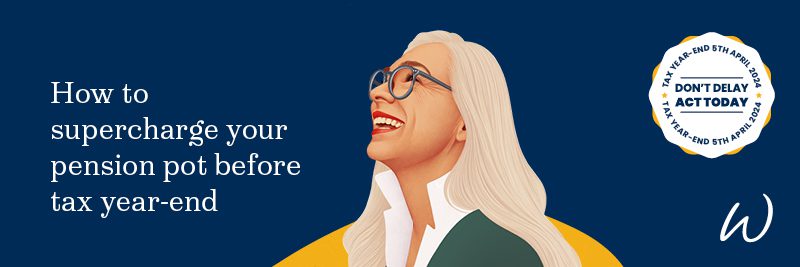How to supercharge your pension pot before tax year-end
The start of the year is the ideal time to firm up those goals for the year ahead – and the decades ahead too. Making tax-smart decisions by tax year-end can make a real difference to the pension pot you can look forward to. Here’s why!

Overview:
- The turbulence of the past couple of years has made many of us rethink our long-term plans, including how we want to spend our retirement.
- Using the full range of tax breaks available on pensions, ISAs, dividends and capital gains will help boost your retirement pot.
- Managing your current assets tax-efficiently will help you achieve your ideal lifestyle.
Planning for your retirement is something that’s easy to put off and worry about later – after all, there’s plenty of time to deal with that, surely? Indeed, some days, the thought of retiring seems unimaginable, while on others, it can’t come soon enough.
However, there’ll come a time when you want to step out of that business-wear and into the next phase of your life. From far-flung holidays to more time spent with loved ones, however you picture it, your dream retirement is something that takes careful financial planning.
Modern retirement planning is about making sure you’ve got plenty of options to live your later life the way you want to, rather than being constrained by your retirement income.
That’s why it really pays to use your tax allowances and reliefs each year to boost your pension pot as you get closer to that eagerly awaited retirement party.
Giving yourself choices
Simply put, the more you save, the more choices you’ll have in retirement. But, amid the current backdrop of the cost-of-living crisis, it’s important about how you save too. Being tax-savvy can make sure your money and assets are working as hard as possible.
The first step is to take a good look at your current financial circumstances. Look at the range of different assets you could save into, including your pension, ISAs or other products. Each one has a varying degree of risk and tax efficiency.
Supercharging your pension
You’ll almost certainly be using pensions and ISA savings as one of your main sources of income in retirement, and we’ll cover the latter in more detail over the next few weeks. Both of these can help shelter your dividends, interest or other profit from tax and help make your money go much further.
Enhancing your pension fund is most effectively achieved through using your full pension annual allowance for the 2023/24 tax year if you can. This encompasses contributions from you, your employer, any third party and the tax relief allocated to the pension. The current annual allowance stands at £60,000. However, you will only receive tax relief on contributions up to 100% of your earnings or £3,600 – whichever is less – within each tax year.
If you haven’t fully used your allowance in the previous three tax years, you can carry it forward for up to three tax years. Any amount paid in excess of your available annual allowance, including any carried forward, will be subject to an income tax charge.
Casting a wider net
Boosting your retirement income doesn’t stop at pensions and ISAs. If you’ve already used up your ISA allowance, there’s still the Personal Savings Allowance (PSA), which can help save tax. You can earn up to £1,000 of interest tax-free in this tax year if you’re a basic-rate taxpayer. This drops to £500 per year for higher-rate taxpayers, and additional-rate taxpayers can’t claim at all.
What’s more, if you make a profit from selling assets outside your ISA or pension, the annual Capital Gains Tax (CGT) exemption for 2023/24 is £6,000. So, if you’re considering selling an asset, it’s worth doing so before tax year-end on 5th April 2024 as the CGT allowance will reduce to £3,000 in 2024/25. You can’t carry this allowance over, so it’s another ‘use-it-or-lose-it’ tax break.
Consider the dividends you earn as well. Dividends earned from shares held in ISAs or received through pensions are tax-free. Moreover, you can earn up to £1,000 before incurring tax on dividends outside these wrappers. It’s important to note that the dividend allowance will decrease to £500 in the 2024/25 tax year. The Dividend Tax for basic-rate taxpayers in 2023/24 is 8.75% and for higher-rate taxpayers, it’s 33.75%. For additional-rate payers, the rate is 39.35%.
Planning your tax-smart retirement together
The tax year may not end until 5th April, but there’s no need to leave everything until the last minute. Whether you wish to make extra pension contributions, top up your ISA or put other changes in place, it’s worth seizing the day and carving out time well before April. It’s also prudent to talk your plans through with a financial adviser and discuss making any changes.
A financial adviser is there to keep on top of changes and give you a heads-up on the tax allowances that can help you feel financially secure about your future. Look forward to retirement, confident that your money will last as long as you need it to – turning those ‘someday dreams into something tangible.
The value of an investment with St. James’s Place will be directly linked to the performance of the funds selected and may fall as well as rise. You may get back less than the amount invested.
The levels and bases of taxation, and reliefs from taxation, can change at any time and are generally dependent on individual circumstances.
